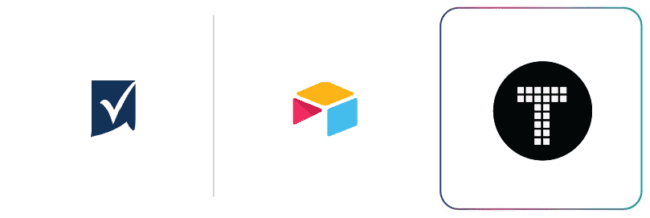LIMITED TIME OFFER
Replace all of these

with a single tool for just $1 per month for your entire team
UNLIMITED USERS
UNLIMITED PROJECTS
UNLIMITED CHATS
UNLIMITED DOCS
UNLIMITED STORAGE
AND MORE..
Streamline Your Workflows with Software Solutions

Efficiency is key to success. Streamlining your workflows not only saves time and resources but also improves productivity and customer satisfaction. One way to achieve this is by using software solutions that automate and simplify your business processes. By understanding the importance of streamlined workflows and the power of software solutions, you can implement effective strategies to optimize your operations.

Understanding the Importance of Streamlined Workflows
The role of efficiency in business success cannot be underestimated. When your workflows are streamlined, tasks are completed in a timely and organized manner, reducing waste and avoiding unnecessary delays. This not only helps you meet deadlines but also ensures that your customers receive the products or services they need promptly. Streamlined workflows also enhance employee satisfaction by eliminating repetitive and manual tasks, allowing them to focus on high-value activities.
Efficiency is the backbone of any successful business. It allows you to do more with less, saving both time and money. When your workflows are efficient, you can handle increased workloads without compromising quality. This enables you to scale your operations and meet the growing demands of your customers. Furthermore, efficient workflows minimize errors and delays, improving customer satisfaction and loyalty.
But how do you identify the bottlenecks in your current workflow? Before integrating software solutions, it’s crucial to closely examine your workflows and pinpoint areas that can be optimized and streamlined. Look for tasks that require excessive time, resources, or manual intervention. These are the areas where software solutions can have the most impact.
The Role of Efficiency in Business Success
Efficiency is not just a buzzword in business; it is a key factor in determining the success of your organization. In today’s fast-paced and competitive market, businesses need to operate at maximum efficiency to stay ahead of the game. By streamlining your workflows, you can eliminate inefficiencies and bottlenecks that hinder productivity and hinder growth.
When your workflows are efficient, you can allocate resources effectively, ensuring that each task is completed in the most optimal way. This not only saves time but also reduces costs, allowing you to allocate your budget to other important areas of your business. Moreover, efficient workflows enable you to respond quickly to customer demands and market changes, giving you a competitive edge.
Efficiency also plays a crucial role in employee satisfaction and engagement. When employees are burdened with repetitive and manual tasks, their morale and productivity suffer. By streamlining workflows and automating mundane tasks, you can free up your employees’ time and energy, allowing them to focus on more meaningful and challenging work. This not only boosts their job satisfaction but also encourages innovation and creativity within your organization.
Identifying Bottlenecks in Your Current Workflow
Identifying bottlenecks in your current workflow is the first step towards streamlining your processes and improving efficiency. Bottlenecks can occur in various forms, such as manual processes, lack of communication, or outdated systems. By closely examining your workflows, you can identify these bottlenecks and take appropriate measures to address them.
One common bottleneck is the reliance on manual processes. Manual tasks are prone to errors, delays, and inconsistencies. By automating these tasks, you can eliminate human error and ensure consistent and accurate results. This not only saves time but also reduces the risk of costly mistakes.
Lack of communication is another common bottleneck in workflows. When different departments or team members are not effectively communicating and collaborating, it can lead to confusion, duplication of efforts, and delays. Implementing communication tools and establishing clear channels of communication can help break down these barriers and improve overall workflow efficiency.
Outdated systems and technologies can also hinder workflow efficiency. Legacy systems may lack the necessary features and integrations to support streamlined processes. By investing in modern software solutions and technologies, you can automate tasks, improve data accuracy, and enhance overall workflow efficiency.
In conclusion, understanding the importance of streamlined workflows is essential for business success. Efficient workflows not only save time and money but also improve customer satisfaction, employee engagement, and overall productivity. By identifying bottlenecks and implementing software solutions, you can optimize your workflows and stay ahead in today’s competitive market.
The Power of Software Solutions
Software solutions revolutionize the way businesses operate. By automating repetitive tasks and providing real-time insights, they empower you to make data-driven decisions and improve overall efficiency. Here’s how software solutions can enhance your workflow:
Imagine a world where every tedious, repetitive task is taken care of by a powerful software solution. No more wasting precious time on manual interventions that are prone to errors. With software solutions, you can bid farewell to those mundane activities and focus on what truly matters – growing your business.
But that’s not all. Software solutions go beyond just automating tasks. They provide seamless integration between different departments and systems, enabling smooth information flow and collaboration. Picture a well-oiled machine, where every cog and gear works together harmoniously to achieve maximum efficiency. That’s the power of software solutions.
Let’s delve deeper into how software solutions enhance workflow:
How Software Solutions Enhance Workflow

Software solutions automate repetitive tasks, eliminating the need for manual intervention. This not only reduces errors but also saves valuable time that can be utilized for more important activities. Just imagine the hours you’ll save by letting a software solution handle those repetitive tasks that used to eat up your day.
But it’s not just about saving time. Software solutions provide a level of accuracy that humans simply can’t match. With algorithms and machine learning capabilities, they can analyze vast amounts of data and provide real-time insights that can guide your decision-making process. No more relying on gut feelings or guesswork – let the data be your guide.
Additionally, software solutions provide seamless integration between different departments and systems, facilitating smooth information flow and collaboration. No more silos or bottlenecks – everyone can access the information they need, when they need it. This leads to streamlined workflows and improved efficiency across your entire organization.
But how do you choose the right software solution for your business? With so many options available in the market, it can be overwhelming. Here are some factors to consider:
Choosing the Right Software for Your Business
Scalability is key. You need a software solution that can grow with your business, accommodating your changing needs and expanding operations. Look for solutions that offer flexibility and scalability, so you don’t have to go through the hassle of switching systems every time your business evolves.
Compatibility is another important factor. Your new software solution should seamlessly integrate with your existing systems and infrastructure. The last thing you want is a clunky, disjointed setup that hampers productivity. Make sure the software solution you choose plays well with others.
User-friendliness is crucial. You want a software solution that is intuitive and easy to use, so your employees can quickly adapt and start reaping the benefits. Complex interfaces and steep learning curves can hinder adoption and slow down the transition process. Prioritize user-friendliness to ensure a smooth implementation.
Lastly, don’t forget about customer support. Even the best software solutions can encounter issues or require assistance. Look for providers that offer reliable customer support, so you can rest easy knowing that help is just a phone call or email away.
Take the time to analyze your workflow requirements and consult with experts to select a software solution that aligns with your goals and objectives. A well-chosen software solution can make a significant difference in your workflow efficiency, propelling your business towards success.
Implementing Software Solutions for Workflow Streamlining
Implementing software solutions for workflow streamlining requires careful planning and execution. Here are steps to ensure successful software integration:
Steps to Successful Software Implementation
- Define your objectives: Clearly outline what you want to achieve through software implementation. Identify specific areas of improvement and set measurable goals.
- Research and select the right software: Thoroughly evaluate software options and select the one that suits your workflow requirements and budget.
- Prepare your team: Educate and train your team members on the new software, ensuring they have the necessary knowledge and skills to maximize its potential.
- Create an implementation plan: Develop a detailed plan that includes timelines, milestones, and responsibilities. This will help ensure a smooth transition to the new software.
- Test and optimize: Prior to full-scale implementation, conduct thorough testing to identify and resolve any issues. Continuously optimize and refine your software integration to maximize efficiency.
Overcoming Challenges in Software Integration
Software integration can present challenges, such as resistance to change and technical issues. To overcome these challenges, communicate the benefits of the software solution to your team and involve them in the decision-making process. Provide adequate training and support to address any skill gaps and encourage open communication throughout the transition. Address technical issues promptly by consulting with software providers or IT professionals. By proactively managing these challenges, you can ensure a successful software integration.
Measuring the Impact of Streamlined Workflows
Measuring the impact of streamlined workflows is essential to gauge the effectiveness of software solutions and identify areas for further improvement. Key performance indicators (KPIs) can help you assess if your workflows are meeting their targets. Here are some KPIs to consider:
Key Performance Indicators for Workflow Efficiency

- Turnaround time: Measure the time taken to complete a task or project from start to finish.
- Resource utilization: Assess how effectively your resources, such as manpower, equipment, and materials, are being utilized.
- Quality metrics: Evaluate the quality and accuracy of your outputs, such as error rates or customer satisfaction ratings.
- Cost savings: Determine the cost savings achieved as a result of streamlined workflows and software integration.
Continuous Improvement through Software Solutions
Improving workflow efficiency is an ongoing process. Software solutions play a vital role in driving continuous improvement by providing real-time data and insights. Regularly analyze your KPIs and identify areas for optimization. Leverage software features such as reporting and analytics to gain deeper visibility into your workflows and make informed decisions. Continuously seek feedback from your team and stakeholders to ensure that your software solutions are meeting their needs. By embracing a culture of continuous improvement, you can achieve long-term success in workflow streamlining.
Streamlining your workflows with software solutions is essential for business growth and sustainability. By understanding the importance of streamlined workflows, harnessing the power of software solutions, implementing them effectively, and continuously measuring their impact, you can optimize your operations and stay ahead in today’s competitive landscape.


